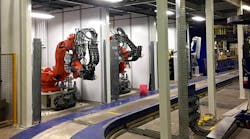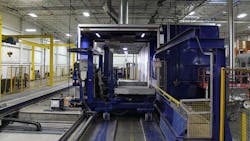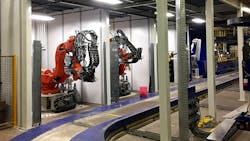How A Michigan Injection Molder Overhauled Its Floor for the Future
ROMEO, Michigan — Forty minutes north of Detroit, up beyond Sterling Heights and Auburn Hills and so many other outer bedroom suburbs, up in the part of the metropolis that can still be called country, is the most innovative manufacturer in Macomb County.
To be fair, Romeo RIM is more innovative than most manufacturers outside Macomb County, too, they just seldom land the headlines to tell people.
Romeo RIM is an injection molding company — the second word of their name is acronym for reaction injection molding, and they focus primarily on long fiber injection (LFI) molding — that churns out composite bumpers, fenders, hoods and other large parts for a customer list that includes John Deere and New Flyer Industries. Just inside their renovated lobby are a handful of their products, among them a hood close to 10 feet long that hangs on the wall and looks a little like a Chicago Bulls logo.
“You immediately get a sense of the products we make, the scale of parts,” said Matt Getty, who started with the company in engineering more than a decade ago and is now VP of business and product development. “We’re not making little injection-molding kinds of stuff. We’re making big parts.”
The company cut its teeth on size. For a while, its claim to fame was that it could manufacture LFI parts larger than anybody else in the world. Then it could manufacture them more quickly than anybody else. Starting in April, though, they literally flipped the switch on what can be described without hyperbole as an LFI game changer — a rotary press system that wheels parts around a track where they are pressed, painted, coated and finished in less than two minutes. It incorporates automation and robots, keeps workers even busier thanks to its sheer speed of about 15 feet per second, and has already sparked modification of how Romeo RIM makes some of its molds.
Oh, and within the next couple years, it should also revolutionize the company’s financial structure, too, accounting for as much as two-fifths of business. “It’s drastic,” Getty said. “And it’s absolutely where we want to grow our company.”
A Look Back, a Step Forward
Romeo RIM is celebrating its 35th anniversary this year, and the one constant in its history is energy-absorbing bumper systems. You see them on buses, the kinds of parts that can be rammed at 5 or 6 mph and still maintain their shape (and keep passengers from whiplash). You see them on every USPS delivery truck, too. “We build 100% of the bumpers on that original platform,” Getty said. “It’s been in service since the 1980s.”
Over time, the company developed into a leader in reaction injection molding, then in-mold painting and high-gloss finishes — “the kind that companies like John Deere, Caterpillar can take right out of the box and put on their vehicles,” Getty said — and, starting in 1999 when it incorporated technology developed by Krauss-Maffei and applied to heavy truck sleeper cab applications, LFI pressing. By 2010, they had figured out how to add those high-gloss, in-mold paint finishes onto mold products on a shuttle press as large as 11-and-a-half feet by 11-and-a-half feet.
“Now we’re taking that same innovation of the in-mold painting we did on the shuttle press,” Getty said, “but we’re putting it into high-speed applications.” The old shuttle press could cycle through in seven to 10 minutes. “Now, we’ll take all those previous innovations and we’ll be able to produce parts in 60 to 120 seconds overall. By the time we push a button, a mold can go around and come back out in a matter of two minutes, and that part is finished. It just needs to be de-flashed and then it can be put right on a vehicle with a high-gloss finish on it.”
Planning and development for the new press started in January 2016, and parts for it started to arrive last summer, general manager Tim Howell said. Romeo RIM wound up building a new warehouse to store it all — because neither the new press nor the old press is at all small, and nobody particularly wanted to store any of it outside.
And how does it work? In its bones, the press still uses equipment supplied by Krauss-Maffei, and incorporates a Rockwell Automation program, Fanuc industrial robots, and resin from Covestro. From there, Romeo RIM cycles parts through as many as seven stops, starting with the human operator.
“We get started with the deloader,” Getty said. “The beauty is that it presents itself so an operator can comfortably deload a part and can effectively get it out and hand it off. … You have an operator cleaning the mold, putting in whatever inserts he needs into the mold. He molds a part, then he sends its back. The parts all get filtered through here.
“The second station is the paint, so ultimate flexibility from the paint, robotically capable. … The robot will go in and robotically spray the tacky of the mold. It’s not done by hand anymore. Because we have several different carriers that go around the track, we have all these different mixes over here for paint. We have six different paint cells that we can put up. For example, press goes through, you pick up one spray head, spray black paint, then send it along. The next would come through, we’d pick up another spray gun, spray green paint on that, send it through. We could do that six different times. … If customers don’t have high-volume programs, they can still reap the cost benefits of one.
“Third is the barrier coat station, and that’s really where the innovation is to bring high-gloss capability to the overall LFI process. That’s what allows us to get a glossy finish on a part” — the secret sauce, Getty called it.
“Four and five are the LFI robots. It’s redundancy and that’s where the LFI technology lives. It’s the fiberglass coming together to create a strong composite part. Four and five are important, of course, because of the redundancy between maintenance and ensuring we’re always making parts. Gets past that, it goes into closing time.”
The whirr of the whole thing in motion, all that simultaneous action and production, is enough to hypnotize even industry veterans. The improvements might hypnotize, too.
“Mold changes are going to be all offline and quicker,” Getty said. “We had to shut the old press down to do mold changes before, and now we do them offline. We were hand-painting, now it’s all robotically applied. The other presses had a 37-inch shut height, so we had to build off mold material to get to that close site. Now, the platens are closer together, so the customer has to buy less mold material. There’s redundant equipment, so if we have to make repairs, the press can keep on rolling. The cost drops dramatically.”
Hearing all those improvements, it’s easy to wonder whether the old system had any benefits. Getty assured there was one.
“It was easier to control,” he said. “We could probably run it on our smartphone now.”
What Does This Mean?
The new press is expected to add millions to Romeo RIM’s bottom line, of course — about $15 million worth of business annually within four or five years — and it should shift customer requirements, too. Above all else, they can opt for aluminum or epoxy molds, among other materials, rather than more expensive steel molds. That one change alone can cut about 30% from a tooling cost capital investment. “You can get into LFI,” Getty said, “and try a part out.”
The company, too, will learn plenty — like how to adapt to a far more connected floor.
“This whole thing is Wi-Fi connected, it’s communicating,” Howell said. “Each of the carriers is kind of like an independent press going around the line, so it is communicating wirelessly through those. The information coming back from the plant, each section of the line has its own function — curing, demolding, painting. This is new for us. We’re not experts, but we’re fast becoming experts.”
Originally a chemical engineer who worked previously as the RIM expert at Ford Motor Company, Howell is learning more about new technologies and said he’s looking forward to “using a little more automation in the next generation. We’ve gone through this molding cycle, bringing it to the next level, the latest technology, from an equipment standpoint. Then it’s just going to be going downstream from what we’re producing from the moldings and doing the same things with trimming.”
A little more than two years into its learn journey, Romeo RIM also expects to learn some new lean lessons.
“One of our big goals now, we have a partnership from an equipment standpoint, and it’s pretty important for us to not have a whole plethora of spare parts that are required,” Howell said. “So anything we can do commonality-wise, we’re doing. We’re trying to narrow down to the best.”
What really excites Howell and the most of the rest of the 115 or so Romeo RIM employees is that the new press has eliminated or reduced the top two causes of downtime — mold changes and mold cleaning.
“We’re going to be a lot more capable of shorter lead times to the customer, minimizing the waste and the whole value stream,” Howell said. “When you can pump out seven parts at a time, without tool changes, it will help lead time to the customer, faster turnaround, less inventory. It’s going to help that whole lead time concern with high complexity.”
As far as advice for other manufacturers considering a similar undertaking, Howell has plenty.
“We had a lot of in-house discussions, we did a lot of planning, and when you undertake and a factory transformation, it’s great to be disruptive,” he said. “We took a conservative team process where we had redundant capacity the old way we were doing it.
“The location where we put this equipment, if we had a blank sheet, we probably wouldn’t have put it where we put it, but (we did) to protect our customer, to make sure they didn’t see any launch effects with the equipment. In line, you have maybe seven systems that have to be up and running and functioning properly, and if one of them goes down, the whole thing goes down. Compromising on the facility layout so we had the existing capacity to support our customers and launching on our own time and not prematurely, that would be my advice.”
The Present, the Future
The main Romeo RIM campus includes a smaller second factory farther back from the road, about as far from the main plant as a par five from tee to green. The focuses back there are LFI and DCPD processes, and plans are in place, Getty said, to renovate and update that, too.
The company owns almost 68 acres, and will “absolutely” need another plant soon. But it will most likely not pop up in Michigan. “A lot of our customers have plants in the Midwest and the Southeast,” Getty said. “So those are strategic locations for us to grow and expand in.”
Sooner or later, then, this new press will be exported, like so many other Michigan products. Somewhere else in America, LFI parts will come off the line in two minutes or less.
Two minutes or less. Just to put that in perspective, in the time you took to read this story — provided you read every word at an average speed of about 200 to 220 words per minute — Romeo RIM switched out somewhere between five and 10 molds and produced somewhere between five and 10 parts. They used to make the largest. Then they made them the fastest. Now they just make them more efficiently than just about everybody else.






